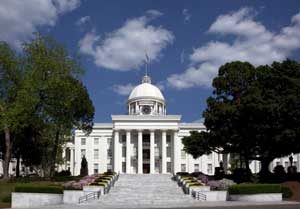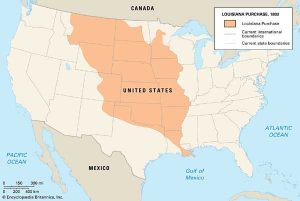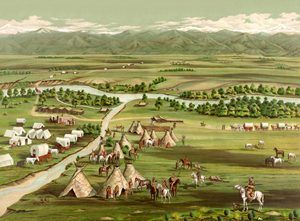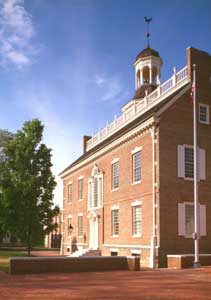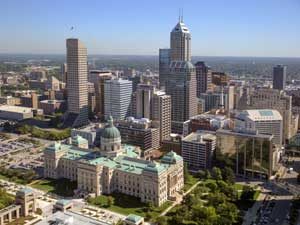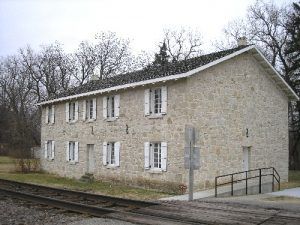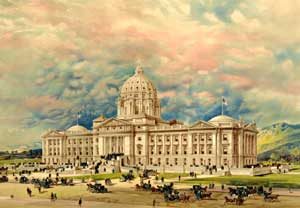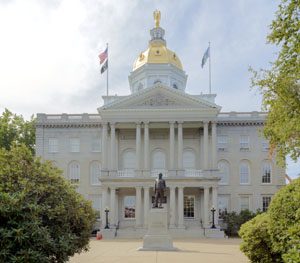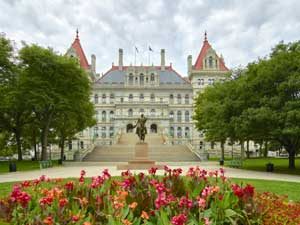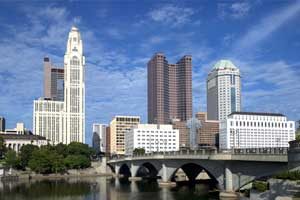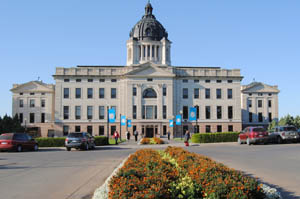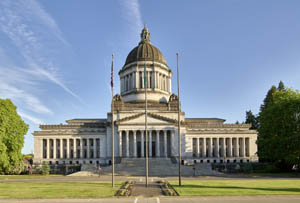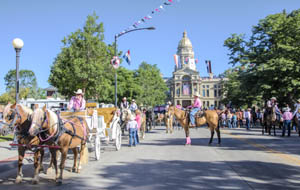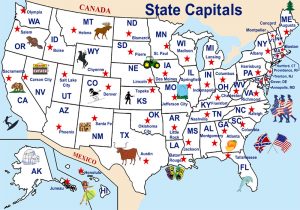
State Capitals in the United States by Legends of America. Click for 8.5 x 11 print version. Click HERE for a Mini-Poster Print.
The capital of the United States is Washington, D.C. Each of the 50 states in the nation has its own capital city. Though some states have changed their capitals, especially when they were territories, most have not changed their capital city since becoming a state.
Alabama – Montgomery – Alabama has had five capitals since it became part of the United States. It became a territory in 1817, when the town of St. Stephens, in present-day Washington County, served as the capital. Two years later, when Alabama achieved statehood in 1819, the capital was moved to Huntsville for the first state constitutional convention. The following year, after much lobbying by political factions, the capital was moved to Cahawba in Dallas County. However, in the following years, as the power centers in the state began to shift, political factions began to push for a new site, and in 1826, the state legislature voted to move the capital Tuscaloosa, where it remained until 1846 when the centrally located Montgomery was selected as the permanent state capital.
Alaska – Juneau – When the United States purchased Alaska from the Russians in 1867, Sitka, the capital of Russian America since 1808, continued to be the territory’s capital. That changed in 1906 when the territorial capital was moved to Juneau. Alaska became the 49th U.S. state on January 3, 1959. Juneau is the largest capital in the country by municipal land area.
Arizona – Phoenix – When Arizona became a U.S. territory in 1863, the first capital was Fort Whipple. However, it was moved to Prescott the following year, in May 1864. In 1867, the territorial capital was moved to Tucson, which was more developed and had more resources. However, in 1877, the capital moved back to Prescott, which had considerable political strength. Amongst the political wrangling, the government chose a location halfway between the two points and chose Phoenix in 1889. Arizona became a state in February 1912, and the capital has since remained in Phoenix, the largest city by population.
Arkansas – Little Rock – In 1804, Arkansas Post became a part of the United States due to the Louisiana Purchase from France. When Arkansas was designated a federal territory in 1819, the capital was placed at Arkansas Post. In 1820, Little Rock became the territorial capital because of its location in the geographical center of the territory and proximity to the Arkansas River. Little Rock remained the capital when Arkansas was admitted to the union as a state in 1836. However, during the Civil War, the state’s Confederate government relocated the capital away twice – the first to Hot Springs and then to Washington in Hempstead County, where it resided until the war’s end. The capital was then returned to Little Rock, where it has remained.
California – Sacramento – The journey of California’s Capitol to its final location in Sacramento took five years. The first State Constitutional Convention was held in 1849 at Colton Hall in Monterey, but just a month later, the legislators moved to a two-story adobe hotel in Pueblo de San Jose, where it stayed until May 1, 1851. In January 1852, the capital moved to Vallejo because San Jose was fairly small and had limited accommodations and services. However, Vallejo was just as limited, and after a very brief stay, the legislature moved to Sacramento on January 5, 1852, where it stayed for about a year. It then moved back to Vallejo for about a month, from January 3, 1853 – February 4, 1853, before moving to Benicia in February 1853. The politicians utilized a new city hall building that was an improvement over the previous capital cities, but the town was too small for the growing state government. One report stated: “At least one hundred men had no place to sleep except barrooms of saloons.” Finally, it was moved back to Sacramento on February 25, 1854, where it has remained since.
Colorado – Denver – After the Pike’s Peak Gold Rush of 1858-1861, the Territory of Colorado was organized as a territory on February 28, 1861, and Colorado City became its first capital. However, it was moved to Golden City two years later, in 1863, remaining until 1869. Finally, it was moved to Denver in 1869, and it has remained there since. Colorado was admitted to the Union in August 1876.
Connecticut – Hartford – Until 1662, the state consisted of two separate colonies — The Connecticut Colony (Hartford) and the New Haven Colony. After King Charles II united them, Hartford was the only capital of the new unit until 1701. That year, the General Court agreed to a plan to have co-capitals, one in New Haven and the other in Hartford. Each city was responsible for different parts of the government, though the General Assembly always met in Hartford. The two capitals continued to operate until 1875 when the General Assembly decided that there should be only one capital and that it should be located at Hartford. Connecticut became a state on January 9, 1788.
Delaware – Dover – The “Three Lower Counties,” which would become the state of Delaware, were once part of Pennsylvania. However, these counties, which were well established, became dissatisfied with William Penn’s rule, and in 1704, he granted them a separate legislature and New Castle became the colonial capital of Delaware. The counties remained a part of Pennsylvania until 1776 when economic, cultural, and political differences fostered a permanent separation. In 1777, the capital was moved from New Castle to Dover because it had a central location that protected it from British raiders on the Delaware River during the American Revolution. Afterward, the state capital was temporarily moved several times to Wilmington, New Castle, and Lewes (twice) before being permanently established at Dover in October of 1781. Delaware became a state on December 7, 1787. Dover is the longest-serving capital in terms of statehood.
Florida – Tallahassee – Under Spanish rule before 1821, Florida was divided into two regions on either side of the Apalachicola River. The capital of East Florida was St. Augustine, and the capital of West Florida was Pensacola. Legislators decided to transfer government business from St. Augustine to Pensacola as a new territory for alternating sessions. However, travel was hazardous and was a 400-mile, 20-day round-trip. In 1824, leaders needed a centralized capital city and chose Tallahassee because it was the midway point between the two principal cities. It has remained there ever since.
Georgia – Atlanta – Georgia has had five different capitals in its history. The first was Savannah, the seat of government during British colonial rule. When Savannah fell to the British forces at the beginning of the Revolutionary War, the capital moved to Augusta and then shuffled around to various sites in Wilkes County, Ebenezer, and possibly even South Carolina before settling again in Savannah in 1782. The capital returned to Augusta in 1786, but ten years later, it was moved to the new city of Louisville, where it remained until 1806. In 1807, the state capital officially moved to Milledgeville, which rapidly declined during Reconstruction. In 1868, it was moved to Atlanta, where it remains today.
Idaho – Boise – Although Lewiston, Idaho, briefly served as Idaho’s capital after forming Idaho Territory in 1863, the territorial Legislature moved the capital to Boise on December 24, 1864. Idaho became a state on July 3, 1890, and the capital remained at Boise.
Hawaii – Honolulu – In the Middle Ages, Hawaii became a monarchy governed by one king or queen who ruled over all Polynesian tribes. The first known European to visit Hawaii was in 1794 when Captain William Brown of the United Kingdom sailed into what is now known as Honolulu Harbor. The Hawaiian monarchy was overthrown by the United States in 1893, and the islands were annexed as a territory of the United States in 1898, With Honolulu as its capital. Hawaii became a state on August 21, 1959, and Honolulu, its largest city, remained the capital.
Illinois – Springfield – After Illinois became a territory in February 1809, Kaskaskia became the territorial capital. When Illinois was admitted to the Union in 1818, Kaskaskia remained the capital until 1820, when it was moved to Vandalia. Within a few years, agitation was started for the removal of the Capital to a site nearer the geographical center of the State. In 1833 the voters were allowed to decide the location, and Alton was selected, but the margin was so slim that the Assembly did not feel bound by the people’s choice, and the Capital was never moved to Alton. The subject arose again in 1837, and Springfield was chosen and remains there today.
Indiana – Indianapolis – After Indiana Territory was created in May 1800, Vincennes became the first territorial capital. However, it was moved to Corydon, a more central location, in 1813. In June 1816, delegates met there to draft the first state constitution, and the state was admitted to the Union in December 1816. On January 1, 1925, the seat of state government relocated to Indianapolis, where it has remained since.
Iowa – Des Moines – The area that is now Iowa was originally part of the Louisiana Purchase and was a part of the Missouri Territory. When Missouri became a state in 1821, this area, along with part of Minnesota and the Dakotas, became an unorganized territory. From 1838 to 1841, Burlington served as the temporary capital of Iowa before Iowa City was designated as the official territorial capital. When the southeastern portion of the unorganized territory was admitted to the Union as the state of Iowa in December 1846, the capital remained at Iowa City. However, with the influx of settlers, citizens felt the state’s capital should be moved to a more central location, and the capital was moved to Des Moines in 1857.
Kansas – Topeka – After the Kansas-Nebraska Act Act passed in May 1854, Kansas became a territory and the question of whether Kansas was to be a free or a slave state would be decided by a vote of Kansans. This immediately caused conflict among the new settlers in what was dubbed Bleeding Kansas. During this period, several places served as territorial capitals, including temporary capitals at Leavenworth for about two months before moving to Shawnee Mission, used as the territorial capital until the following spring. The first official capital was designated in the now-extinct town of Pawnee, but the building was only used for five days before the legislature returned to the Shawnee Mission. In August 1855, the Territorial Legislature selected Lecompton, which continued as the capital during the remainder of the Territorial period. Kansas became a state on January 29, 1861, and at an election in November 1861, the people selected Topeka as the permanent capital of Kansas.
Kentucky – Frankfort – After 1775, Kentucky grew rapidly as the first settlements west of the Appalachian Mountains were founded. Virginia claimed the region as part of its territory. However, after several years, most residents wanted to separate from Virginia because of the distance to the Virginia state capital and the region’s trade and economy. In 1788, Virginia consented to Kentucky’s statehood, and Kentucky’s final push for statehood officially began with a convention held at Danville in April 1792. In June 1792, Kentucky was admitted to the Union, and Frankfort became the state capital the same year after pledging more manpower toward constructing a statehouse than any other city.
Louisiana – Baton Rouge – New Orleans was founded in 1718 and became the capital of the French colony of Louisiana in 1722. In 1803, the region was sold as part of the Louisiana Purchase to the United States, at which time, New Orleans continued to be the capital of the Territory of Orleans. Louisiana became a state on April 30, 1812, and the State Legislature passed a resolution declaring that the seat of government be moved to a “more convenient place.” However, no action was taken until 1829, when the Legislature voted to move to Donaldsonville. It convened for the first time in Donaldsonville in January 1830; however, the leaders were “dissatisfied with the quarters there” and adjourned shortly after that to return to New Orleans. In 1847, the city of Baton Rouge donated land for the construction of the new capital, which was dedicated in December 1849. After the Civil War began, New Orleans and Baton Rouge were occupied by the Union Army, and the state government was moved to Opelousas in 1862 and then to Shreveport in 1864. In the meantime, the vacant capitol in Baton Rouge was gutted by an accidental fire. After the war, the state government returned to New Orleans, meeting in various places until they could appropriate money to rebuild the Old State Capitol. After the completion of the renovations, the legislature returned in May 1882.
Maine – Augusta – Once part of Massachusetts, long-standing disagreements over land speculation and settlements led to Maine residents wanting to secede from the state. In 1819, Massachusetts agreed to permit secession, and Maine became the 23rd state on March 15, 1820. Its state capital was Portland, Maine’s largest city until it was moved to the more central Augusta in 1832. The principal office of the Maine Supreme Judicial Court remains in Portland.
Maryland – Annapolis – The Maryland State House housed the workings of the United States government from November 26, 1783, to August 13, 1784, and the Treaty of Paris was ratified there on January 14, 1784, so Annapolis became the first peacetime capital of the U.S. When Maryland became a state on April 28, 1788, Annapolis became its capital. It is the smallest capital city by land area in the nation.
Massachusetts – Boston – Being one of the oldest cities in the country, founded in 1630, Boston was the choice for the capital of what was originally known as the Massachusetts Bay Colony. When Massachusetts became the sixth state to join the United States on February 6, 1788. However, Boston was not the first capital of the territory as Plymouth predates Boston and was the capital of Massachusetts back when it was known as Plymouth Colony. Today, Boston is the longest continuously serving capital.
Michigan – Lansing – After more than a century of French and British rule, the United States government set aside the Michigan region as part of the Northwest Territory in 1787. After Congress created the Territory of Michigan in 1805, Detroit became the territorial capital on July 1, 1805. When Michigan became a state on January 26, 1837, Detroit remained the capital until March 1847, when the governor signed a bill naming Lansing Township in Ingham County the new capitol. Horrified observers, noting that there was not so much as a village at the location, termed it a “howling wilderness,” a wooden structure was hastily erected to serve as a temporary capitol building. In January 1848, the capital moved, and a settlement called “Michigan, Michigan,” began to rise around it, but was changed a few months later to “Lansing.”
Minnesota – St. Paul – Located in east-central Minnesota along the banks of the Mississippi River, St. Paul became the territorial capital of Minnesota when it was split from Iowa and Wisconsin territories in March 1849. When Minnesota became a state in May 1858, it remained the capital city and has since.
Mississippi – Jackson – Mississippi was created from organized territory of the United States in April 1798, and Natchez, a substantial frontier settlement on the Mississippi River, became the first capital. However, political rivalry moved the capital to Washington, a small community six miles east of Natchez, in 1802. Washington remained the capital when the territory became a state in December 1817. By 1821, efforts were underway to place the capital in the state’s center, and a legislative commission decided on Le Fleur’s Bluff on the Pearl River, where the town of Jackson was planned. After building the first statehouse, the legislature first met in December 1822.
Missouri – Jefferson City – When the Missouri Territory was organized in June 1812, St. Louis became the seat of government. However, when Missouri was admitted as a state in August 1821, the capital was moved to nearby St. Charles. However, the legislature wanted a more central location and chose the site of Jefferson because not only was it central, but it was also located near the junction of the Missouri and Osage Rivers, which connected to all other rivers, making a pre-railroad highway system and was situated on a bluff which offered flood protection. First known as Lohman’s Landing, plans were made for a town and the construction of a capital building. The town was named in honor of Thomas Jefferson, and the legislature first met in Jefferson City in 1826.
Montana – Helena – In May 1864, the Montana Territory was organized out of the existing Idaho Territory, and Helena became the territorial capital in 1875. When Montana was admitted as the 41st state in the Union in November 1889, the capital remained, and Helena remained there.
Nebraska – Lincoln – The Territory of Nebraska was created by the Kansas-Nebraska Act in May 1854, and Omaha became the territorial capital. However, this was inconvenient to many people who lived south of the Platte River as it was difficult to cross. When Nebraska became a state in March 1867, a commission soon met to select a new location for the capital, and the small village of Lancaster was chosen in July. The town’s name was soon changed to Lincoln after President Abraham Lincoln, and a new capitol building was completed on December 1, 1868.
Nevada – Carson City – Nevada Territory was organized in March 1861, and Genoa, the first settlement, became the provisional capital for a brief time before it was moved to Carson City. When Nevada was admitted to the Union in October 1864, the capital remained at Carson City and continues today.
New Hampshire – Concord – Portsmouth was the capital of the colony of New Hampshire in 1689. One of the Thirteen Colonies that revolted against British rule during the American Revolution (1765-1783), New Hampshire’s General Assembly shuttled around during the war to various places, including Concord, Hopkinton, Dover, Amherst, Charlestown, and Hanover, before officially settling in Exeter. In January 1776, it became the first colony to set up an independent government and the first to establish a constitution. After the war, New Hampshire citizens clamored for a centrally located capital, and travel-weary lawmakers agreed. Concord became New Hampshire’s de facto capital in 1808, though not by law until 1816.
New Jersey – Trenton – Elizabeth, New Jersey, was the first capital during the colonial period. First called “Elizabethtown,” it was founded in 1664 by English settlers and named the provincial capital in 1668. On December 18, 1787, New Jersey ratified the new Constitution and became the third state to join the Union. Trenton was made the official capital of New Jersey in 1790.
New Mexico – Santa Fe – Established in 1610, Santa Fe, New Mexico, is the third oldest city and oldest capital city, founded by European colonists in the United States. Santa Fe was the capital of the “Kingdom of New Mexico,” which was claimed for Spain by Francisco Vasquez de Coronado in 1540. Santa Fe remained Spain’s provincial seat until 1821, when Mexico won its independence from Spain, and Santa Fe became the capital of the Mexican territory. In 1848, Mexico signed the Treaty of Guadalupe Hidalgo, ceding New Mexico and California to the United States. When New Mexico was admitted to the Union as the 47th state on January 6, 1912, Santa Fe remained the capital, making it the longest-serving capital in the United States. It is also the highest in elevation at 7,000 ft.
New York – Albany – In September 1777, New York leaders met in Kingston to declare the province a sovereign state and establish the first New York State Senate. The state was the 11th to join the Union on July 26, 1788, and afterward, the Legislature frequently moved the state capital between Albany, Kingston, Hurley, Poughkeepsie, and New York City. In 1797, the state capital of New York was moved permanently to Albany.
North Carolina – Raleigh – Bath, the oldest town in North Carolina, was the first nominal capital from 1705 until 1722, when Edenton took over the role. Years passed before modest government facilities became available. Several efforts to establish a seat of state government failed until 1766 when the town of New Bern was selected. Here, construction began on several new buildings. When New Bern was threatened by enemy attacks during the American Revolution, the government took to the roads, meeting in the state’s coastal and inland towns. In the meantime, the state’s population had moved westward, and in 1788, a State Convention voted to fix the capital within ten miles of Isaac Hunter’s plantation in Wake County. A committee later purchased 1,000 acres of Joel Lane’s plantation, and a plan for the new city of Raleigh was drawn up. Raleigh became the capital of North Carolina in 1792.
North Dakota – Bismarck – When the Dakota Territory was established in 1861, the capital was located at Yankton in present-day South Dakota. However, this was a problem because it was so far away from developing cities such as Deadwood and Fargo. It was also not on a transcontinental railroad line. Eventually, a commission was formed to find a new place for the capital, and Bismarck became the new territorial capital in April 1883. The first capitol building was constructed between 1883 and 1884 to house the territorial government. When North Dakota became a state on November 2, 1889, the capital remained at Bismarck.
Ohio – Columbus – When the American Revolution ended in 1783, the area that would become Ohio became part of the United States. A few years later, in 1787, the United States created the Northwest Territory, including what would later become Illinois, Indiana, Michigan, Wisconsin, and part of Minnesota. In 1800, the Ohio territorial capital was established at Chillicothe, and in 1802 as Ohio moved toward statehood, the city hosted the Ohio Constitutional Convention. On March 1, 1803, Ohio was admitted into the Union as the 17th state, and Chillicothe remained the capital. In 1810, the state government moved to Zanesville, but it stayed there are two years before returning to Chillicothe. In 1816, the capital moved for a final time to Columbus, where it remains today.
Oklahoma – Oklahoma City – In 1825, all the land lying west of the Mississippi River was designated “Indian Country.” However, as more and more people pushed westward, the Indian Territory would encompass the present states of Oklahoma, Kansas, Nebraska, and part of Iowa. Through treaties, many tribes were pushed into this region. However, the Indian Territory shrank as much of this area became states, leaving only Oklahoma as the designated Indian Territory. Soon this area was reduced again when Oklahoma Territory was created from part of it by the Organic Act in May 1890. At that time, Guthrie was made the territorial capital. Oklahoma became the 46th state to enter the union on November 16, 1907. In 1910, the state allowed the voters to decide whether or not to move the capital to Oklahoma City, and after passing, Oklahoma City became the official capital in June. To this date, Oklahoma City is the shortest-serving current state capital.
Pennsylvania – Harrisburg – From 1681 until 1729, Pennsylvania’s colonial legislature would meet wherever it could find the space, which included taverns, private residences, and town halls. In 1729, the Pennsylvania Assembly voted to appropriate money to build a statehouse in Philadelphia. Known as Independence Hall today, it was finished and occupied in 1735 and became famous as the colonies moved toward revolution. Here, both the Declaration of Independence and the new nation’s Constitution were debated and signed. From 1790 to 1800, when Philadelphia was the nation’s capital, the state and national legislatures met in the building. By 1799, the State Assembly moved westward to Lancaster, and a year later, Congress convened in Washington, D.C. However, Lancaster’s life as the state capital would be brief, as it moved to Harrisburg in 1812 and has remained since.
Oregon – Salem – The Territory of Oregon became an organized territory of the United States on August 14, 1848, and Oregon City became the territorial capital at the end of the Oregon Trail. A large territory, it also included the future states of Idaho, Washington, and part of Montana. As Oregon continued to grow, it eventually broke off from the other regions in the territory, and on February 14, 1859, Oregon was admitted into the Union as the 33rd state. On May 14, 1852, the capital was moved to Salem.
Rhode Island – Providence – Between 1681 and 1854, the government of Rhode Island rotated between Providence, Newport, Bristol, East Greenwich, and Kingston. In the meantime, Rhode Island became the last of the original 13 colonies to ratify the Constitution on May 29, 1790. In 1854 the state began to rotate its capital between Newport and Providence, a practice that continued for more than 40 years. By 1900, Providence had grown, and Newport had declined, and in 1901, Providence became the sole capital of Rhode Island.
South Carolina – Columbia – Charleston was its capital when South Carolina was a colony. In March 1786, the legislature decided to build a town and move the seat of government to Columbia. South Carolina became the eighth state to ratify the U.S. Constitution on May 23, 1788. Two years later, In January 1790, the legislature met at Columbia in the unfinished statehouse for the first time.
South Dakota – Pierre – When the Territory of Dakota was created on March 2, 1861, Yankton, South Dakota, served as the first territorial capital. It was moved to Bismarck, in present-day North Dakota, two years later. On November 2, 1889, the territory was split and admitted to the Union as North and South Dakota states. At that time, Pierre was designated as the state capital when South Dakota.
Tennessee – Nashville – The Territory South of the River Ohio, more commonly known as the Southwest Territory, was an organized incorporated territory of the United States that was established in May 1790. Tennessee was admitted to the Union as the 16th state on June 1, 1796, and Knoxville was made the first capital city. In 1812, the general assembly moved to Nashville, where it stayed for five years. Kingston served as the capital for one day when the general assembly met in 1807 to fulfill a treaty obligation with the Cherokee Indians. In 1817, the capital returned to Knoxville, but in 1818, the general assembly moved to Murfreesboro in the state’s geographic center. There it met at the local Presbyterian Church until 1826, when it moved to Nashville for the last time.
Texas – Austin – Before Texas became its own republic, its capital under Spanish rule was Monclova, in the present-day Mexican state of Coahuila. In 1721, the capital was located in Los Adaes (modern-day Robeline, Louisiana) and remained there for half a century. The seat of government was then moved to San Antonio in 1772, where it remained until 1824. After the Mexican War of Independence, Texas was united with Coahuila, with Saltillo as the provincial capital. On March 9, 1833, Monclova was made the capital of Coahuila and Texas. In March 1836, Texas declared its independence at Washington-on-the-Brazos. That year, the newly independent government met at several places, including Harrisburg and Velasco, before making Columbia the first capital of the Republic of Texas in October 1836. The next year, the capital moved to Houston, where it stayed until 1839. That year, Waterloo was chosen to replace Houston as the capital of Texas. Shortly after, the city’s name was changed to Austin in honor of Stephen F. Austin, the “Father of Texas” and the first Secretary of State for the republic. When President Samuel Houston feared an attack on Austin by the Mexicans, the government was returned to Houston on March 13, 1842. The Constitution of 1845 provided that Austin be the capital until 1850, when a vote was required to choose the permanent capital. Austin won the majority, but another election was scheduled for 20 years later and held in 1872, at which time Austin won again. It has remained there since.
Utah – Salt Lake City – The Territory of Utah was established in September 1850, and in 1851, Brigham Young made Fillmore, located in central Utah, the territorial capital. Construction on the capitol building began in 1852, and in 1855, the territorial legislature met there for the first and only time. In 1856, the legislature moved the Territorial Capital to the larger community of Salt Lake City, which has remained since. On January 4, 1896, Utah was admitted to the Union as the 45th state.
Vermont – Montpelier – Vermont started as a disputed territory between New York and New Hampshire. Still, in January 1777, area representatives met in Westminster, declared the state independent, and called it The Republic of New Connecticut. Almost six months later, representatives of the new republic met in Windsor and changed the name to the Republic of Vermont. At first, the Vermont General Assembly met only once every two years, and the seat of government shifted between towns east and west of the Green Mountains. Vermont officially became a state on March 4, 1791, but the capital continued to shift until 1805 when the General Assembly chose Montpelier as the new seat of the state government. Montpelier, located near the state’s center, is the nation’s smallest capital by population.
Virginia – Richmond – The first colonial settlement in Virginia was Jamestown, which served as the colonial capital from 1616 until 1699. Williamsburg served as the capital of the Colony and Commonwealth of Virginia from 1699 to 1780 and was the center of political events in Virginia that led to the American Revolution. When the war began, Governor Thomas Jefferson urged the capital to be relocated to Richmond in 1780. Today, Virginia’s capital, Richmond, houses the oldest elected legislative body in North America, the Virginia General Assembly, first established as the House of Burgesses in 1619.
Washington – Olympia – The Territory of Washington was established from the portion of the Oregon Territory north of the lower Columbia River in March 1853. Initially, it included Idaho and parts of Montana and Wyoming before attaining its final boundaries in 1863. At that time, Olympia was chosen as the territorial capital. As Washington worked toward statehood, multiple settlements contended for the title of capital, including Olympia, Steilacoom, Vancouver, and Port Townsend. However, when Washington was admitted as a state in November 1889, the capital remained at Olympia.
West Virginia – Charleston – When the state seceded from Virginia and the Confederacy in early 1861, the seat of government was held at Wheeling. West Virginia became the 35th state in the Union on June 20, 1863. By 1865, the government outgrew the building in Wheeling and voted to move to Charleston, which was to be the permanent capital city. However, the legislature remained in Wheeling until 1870, when the new building was completed. The legislature met in the building until 1875 when the City of Wheeling offered to build a new capitol building if the legislature would agree to return to the city. Fueled by the fact that Charleston did not have railroad access, the capital was moved back to Wheeling in 1875. However, in 1877, a statewide election was held to determine a permanent capital, and Charleston won.
Wisconsin – Madison – The Territory of Wisconsin, established in July 1836, initially included the present-day states of Wisconsin, Minnesota, Iowa, and part of the Dakotas east of the Missouri River. The first territorial capital was established at Belmont, Wisconsin. In 1837, a new building was constructed at Burlington, Iowa, which became the second capital of the territory. In 1838 the U.S. Congress created the Territory of Iowa, which forced the Wisconsin legislature to move to Madison sooner than intended. When Wisconsin became a state on May 29, 1848, the capital remained in Madison.
Wyoming – Cheyenne – The Territory of Wyoming was established in July 1868, and Cheyenne, on the path of the transcontinental railroad, became the territorial capital in 1869. The Wyoming State Capitol was constructed between 1886 and 1890. Wyoming was admitted to the Union on July 10, 1890, and the capital has remained in Cheyenne since.
© Kathy Alexander/Legends of America, updated February 2024.
Also See:
Bucket List Attraction in Each State

